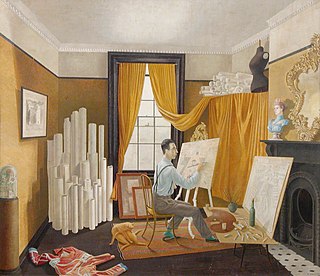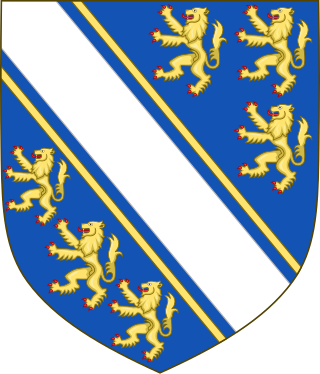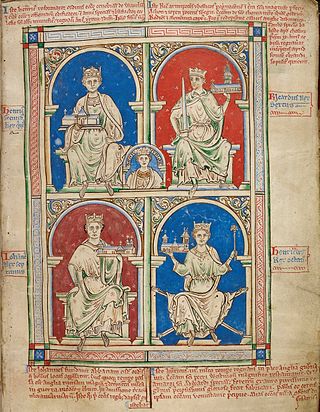Related Research Articles
Year 1213 (MCCXIII) was a common year starting on Tuesday of the Julian calendar.

Mary de Bohun was the first wife of Henry Bolingbroke, Earl of Northampton and Hereford and the mother of King Henry V. Mary was never queen, as she died before her husband came to the throne as Henry IV.

Saffron Walden is a market town in the Uttlesford district of Essex, England, 12 miles (19 km) north of Bishop's Stortford, 15 miles (24 km) south of Cambridge and 43 miles (69 km) north of London. It retains a rural appearance and some buildings of the medieval period. The population was 15,504 at the 2011 census and 16,613 in the 2021 census.
Medieval studies is the academic interdisciplinary study of the Middle Ages. A historian who studies medieval studies is called a medievalist.

England in the Middle Ages concerns the history of England during the medieval period, from the end of the 5th century through to the start of the early modern period in 1485. When England emerged from the collapse of the Roman Empire, the economy was in tatters and many of the towns abandoned. After several centuries of Germanic immigration, new identities and cultures began to emerge, developing into kingdoms that competed for power. A rich artistic culture flourished under the Anglo-Saxons, producing epic poems such as Beowulf and sophisticated metalwork. The Anglo-Saxons converted to Christianity in the 7th century, and a network of monasteries and convents were built across England. In the 8th and 9th centuries, England faced fierce Viking attacks, and the fighting lasted for many decades. Eventually, Wessex was established as the most powerful kingdom and promoting the growth of an English identity. Despite repeated crises of succession and a Danish seizure of power at the start of the 11th century, it can also be argued that by the 1060s England was a powerful, centralised state with a strong military and successful economy.

Edward Bawden, was an English painter, illustrator and graphic artist, known for his prints, book covers, posters, and garden metalwork furniture. Bawden taught at the Royal College of Art, where he had been a student, worked as a commercial artist and served as a war artist in World War II. He was a fine watercolour painter but worked in many different media. He illustrated several books and painted murals in both the 1930s and 1960s. He was admired by Edward Gorey, David Gentleman and other graphic artists, and his work and career is often associated with that of his contemporary Eric Ravilious.

Conrad le Despenser Roden Noel was an English priest of the Church of England. Known as the 'Red Vicar' of Thaxted, he was a prominent Christian socialist.

Timothy Alan Reuter, grandson of the former mayor of Berlin Ernst Reuter, was a German-British historian who specialized in the study of medieval Germany, particularly the social, military and ecclesiastical institutions of the Ottonian and Salian periods.

Clare Castle is a high-mounted ruinous medieval castle in the parish and former manor of Clare in Suffolk, England, anciently the caput of a feudal barony. It was built shortly after the Norman Conquest of England in 1066 by Richard Fitz Gilbert, having high motte and bailey and later improved in stone. In the 14th century it was the seat of Elizabeth de Clare, one of the wealthiest women in England, who maintained a substantial household there. The castle passed into the hands of the Crown and by 1600 was disused. The ruins are an unusually tall earthen motte surmounted by tall remnants of a wall and of the round tower, with large grassland or near-rubble gaps on several of their sides. It was damaged by an alternate line of the Great Eastern Railway in 1867, the rails of which have been removed.
Nigel Saul is a British academic who was formerly the Head of the Department of History at Royal Holloway, University of London (RHUL). He retired in 2015 and is now Emeritus Professor. He is recognised as one of the leading experts in the history of medieval England.

Eleanor de Bohun was the elder daughter and co-heiress, of Humphrey de Bohun, 7th Earl of Hereford (1341–1373) and Joan Fitzalan, a daughter of Richard FitzAlan, 10th Earl of Arundel and his second wife Eleanor of Lancaster.
Pauline Stafford is Professor Emerita of Early Medieval History at Liverpool University and a visiting professor at Leeds University in England. Dr. Stafford is a former vice-president of the Royal Historical Society.
Henrietta Leyser is an English historian. She is an expert on the history of medieval England, in particular the role of women.

In the history of England, the High Middle Ages spanned the period from the Norman Conquest in 1066 to the death of King John, considered by some historians to be the last Angevin king of England, in 1216. A disputed succession and victory at the Battle of Hastings led to the conquest of England by William of Normandy in 1066. This linked the Kingdom of England with Norman possessions in the Kingdom of France and brought a new aristocracy to the country that dominated landholding, government and the church. They brought with them the French language and maintained their rule through a system of castles and the introduction of a feudal system of landholding. By the time of William's death in 1087, England formed the largest part of an Anglo-Norman empire, ruled by nobles with landholdings across England, Normandy and Wales. William's sons disputed succession to his lands, with William II emerging as ruler of England and much of Normandy. On his death in 1100 his younger brother claimed the throne as Henry I and defeated his brother Robert to reunite England and Normandy. Henry was a ruthless yet effective king, but after the death of his only male heir William Adelin, he persuaded his barons to recognise his daughter Matilda as heir. When Henry died in 1135 her cousin Stephen of Blois had himself proclaimed king, leading to a civil war known as The Anarchy. Eventually Stephen recognised Matilda's son Henry as his heir and when Stephen died in 1154, he succeeded as Henry II.
Joan FitzAlan, Countess of Hereford, Countess of Essex and Countess of Northampton was the wife of the 7th Earl of Hereford, 6th Earl of Essex and 2nd Earl of Northampton. She was the mother of Mary de Bohun, the first wife of Henry of Bolingbroke who later reigned as King Henry IV, and Eleanor de Bohun, Duchess of Gloucester. She was the maternal grandmother of King Henry V.
The economics of English towns and trade in the Middle Ages is the economic history of English towns and trade from the Norman invasion in 1066, to the death of Henry VII in 1509. Although England's economy was fundamentally agricultural throughout the period, even before the invasion the market economy was important to producers. Norman institutions, including serfdom, were superimposed on a mature network of well-established towns involved in international trade. Over the next five centuries the English economy would at first grow and then suffer an acute crisis, resulting in significant political and economic change. Despite economic dislocation in urban areas, including shifts in the holders of wealth and the location of these economies, the economic output of towns developed and intensified over the period. By the end of the period, England would have a weak early modern government overseeing an economy involving a thriving community of indigenous English merchants and corporations.

Walden Castle was a medieval castle in Essex, England, built during the Anarchy of the 12th century. Only the ruined core of the structure remains today.
Joan Leche, benefactress, was the wife successively of Thomas Bodley, and of Thomas Bradbury, Lord Mayor of London in 1509. She founded a chantry in London, and a grammar school in Saffron Walden, Essex. Her great-grandson, Sir John Leveson (1555–1615), was instrumental in putting down the Essex rebellion of 8 February 1601, and her great-grandson William Leveson acted as trustee for the original shareholders of the Globe Theatre.

The Abbey of the Minoresses of St. Clare without Aldgate was a monastery of Franciscan women living an enclosed life, established in the late 13th century on a site often said to be of five acres, though it may have been as little as half that, at the spot in the parish of St. Botolph, outside the medieval walls of the City of London at Aldgate that later, by a corruption of the term minoresses, became known as The Minories, a placename found also in other English towns including Birmingham, Colchester, Newcastle upon Tyne and Stratford-upon-Avon.

John FitzWalter, 2nd Baron FitzWalter was a prominent Essex landowner best known for his criminal activities, particularly around Colchester. His family was of a noble and ancient lineage, with connections to the powerful de Clare family, who had arrived in England at the time of the Norman Conquest. The FitzWalters held estates across Essex, as well as properties in London and Norfolk. John FitzWalter played a prominent role during the early years of King Edward III's wars in France, and at some point, FitzWalter was married to Eleanor Percy, the daughter of Henry, Lord Percy.
References
- ↑ Watt, Diane. (Ed.) (1997). Medieval Women in Their Communities. Toronto: University of Toronto Press. p. 12. ISBN 978-0-8020-8122-3.